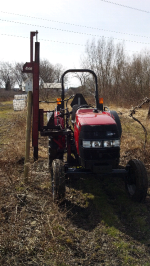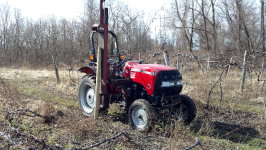mickeyw
Bronze Member
- Joined
- Dec 10, 2012
- Messages
- 64
- Location
- Surrey, UK
- Tractor
- 1987 Renault 68-12, 1981 JD1640, 1973 Ford 3000
Here in the UK, we typically use split chestnut stakes (approx. 4-5 diameter and halved) and barbed wire or for fencing suitable for cattle and sheep. The posts are normally 5? or 6? and go 8-12 into the ground. Over the years I have put a lot of posts in the ground, just using a manual post rammer. Itç—´ hard work for sure, and the older you get, the harder the job gets. My former youthful energy seems to have got up and left me.
I have been thinking about easier ways to push fence posts into the ground. Our needs and certainly our budget don't permit some of the fancy manufactured tractor mounted post ramming gear, as nice as it is.
I don稚 have access to a 360 digger or a tractor that can push down with the bucket. Our Ford 3000 uses gravity to drop the FEL, it doesn't get much cheaper than free
So I've been researching and thinking how I could make a tractor mounted device as cheaply as possible. I've seen some pretty ingenious ideas, but these have mostly been applied to larger, heavier machines with power down available on the FEL.
Instead I wondered about have a 3 point mounted hydraulic cylinder that would use the tractor's own weight to push the post in, so working like a hydraulic jack really.
Having recently been building a hydraulic splitter with a 10 tonne cylinder on it, I considered the cylinder could be put to a secondary use to save money. The stroke at 500mm (19? would be ideal.
Has anyone tried something like this? Do you think it would have enough downward force? I am thinking of using such a tool fitted to our JD1640. I don't know how much it weighs? Must be at least 2-3 tonnes? Are the link arms man enough to lift the tractor?
The ground round our way is predominantly clay, so pretty soft in the wetter seasons (that's all year round right now ) but goes pretty solid in the summer (if we ever get any).
) but goes pretty solid in the summer (if we ever get any).
Your thoughts please gentlemen...
I have been thinking about easier ways to push fence posts into the ground. Our needs and certainly our budget don't permit some of the fancy manufactured tractor mounted post ramming gear, as nice as it is.
I don稚 have access to a 360 digger or a tractor that can push down with the bucket. Our Ford 3000 uses gravity to drop the FEL, it doesn't get much cheaper than free
So I've been researching and thinking how I could make a tractor mounted device as cheaply as possible. I've seen some pretty ingenious ideas, but these have mostly been applied to larger, heavier machines with power down available on the FEL.
Instead I wondered about have a 3 point mounted hydraulic cylinder that would use the tractor's own weight to push the post in, so working like a hydraulic jack really.
Having recently been building a hydraulic splitter with a 10 tonne cylinder on it, I considered the cylinder could be put to a secondary use to save money. The stroke at 500mm (19? would be ideal.
Has anyone tried something like this? Do you think it would have enough downward force? I am thinking of using such a tool fitted to our JD1640. I don't know how much it weighs? Must be at least 2-3 tonnes? Are the link arms man enough to lift the tractor?
The ground round our way is predominantly clay, so pretty soft in the wetter seasons (that's all year round right now
Your thoughts please gentlemen...

